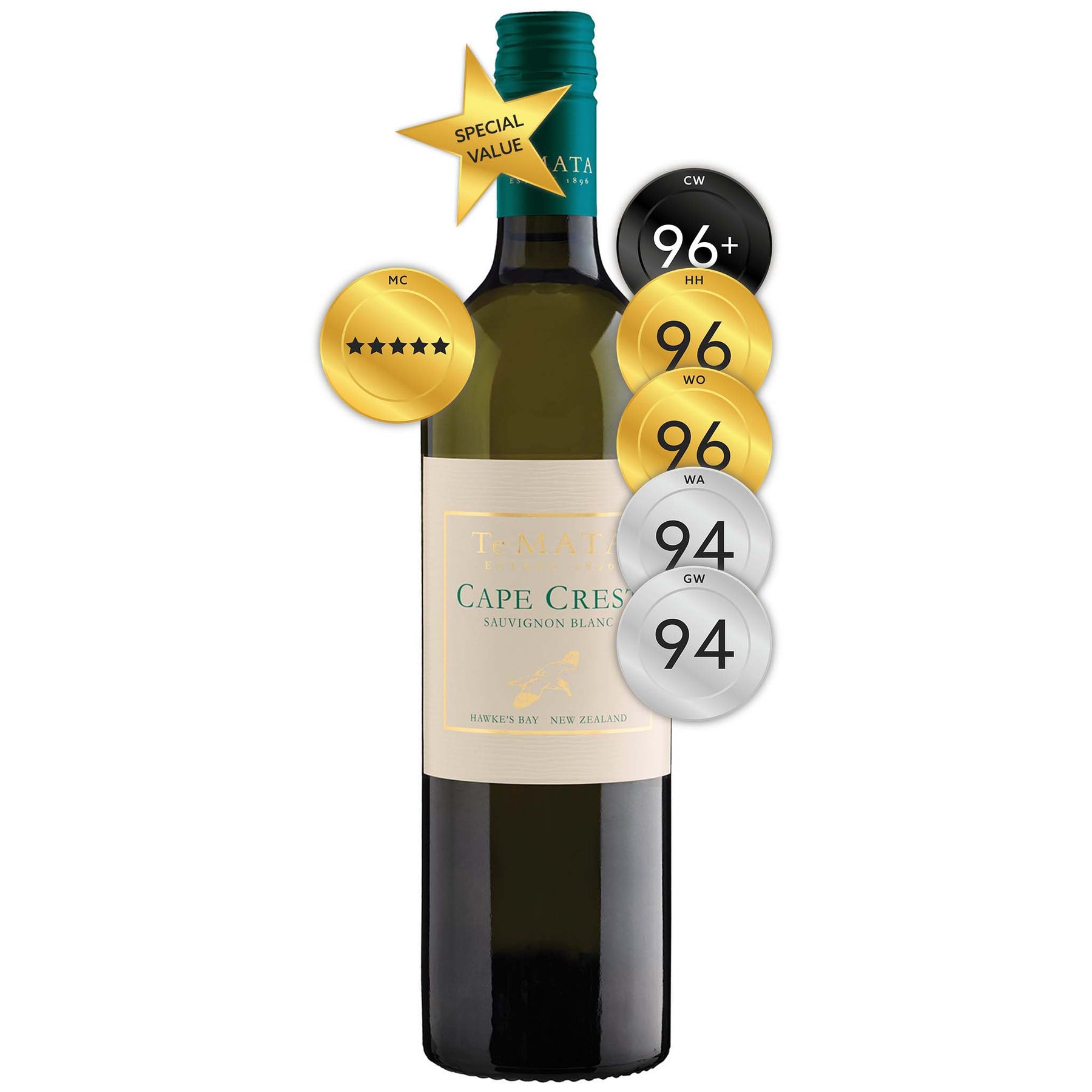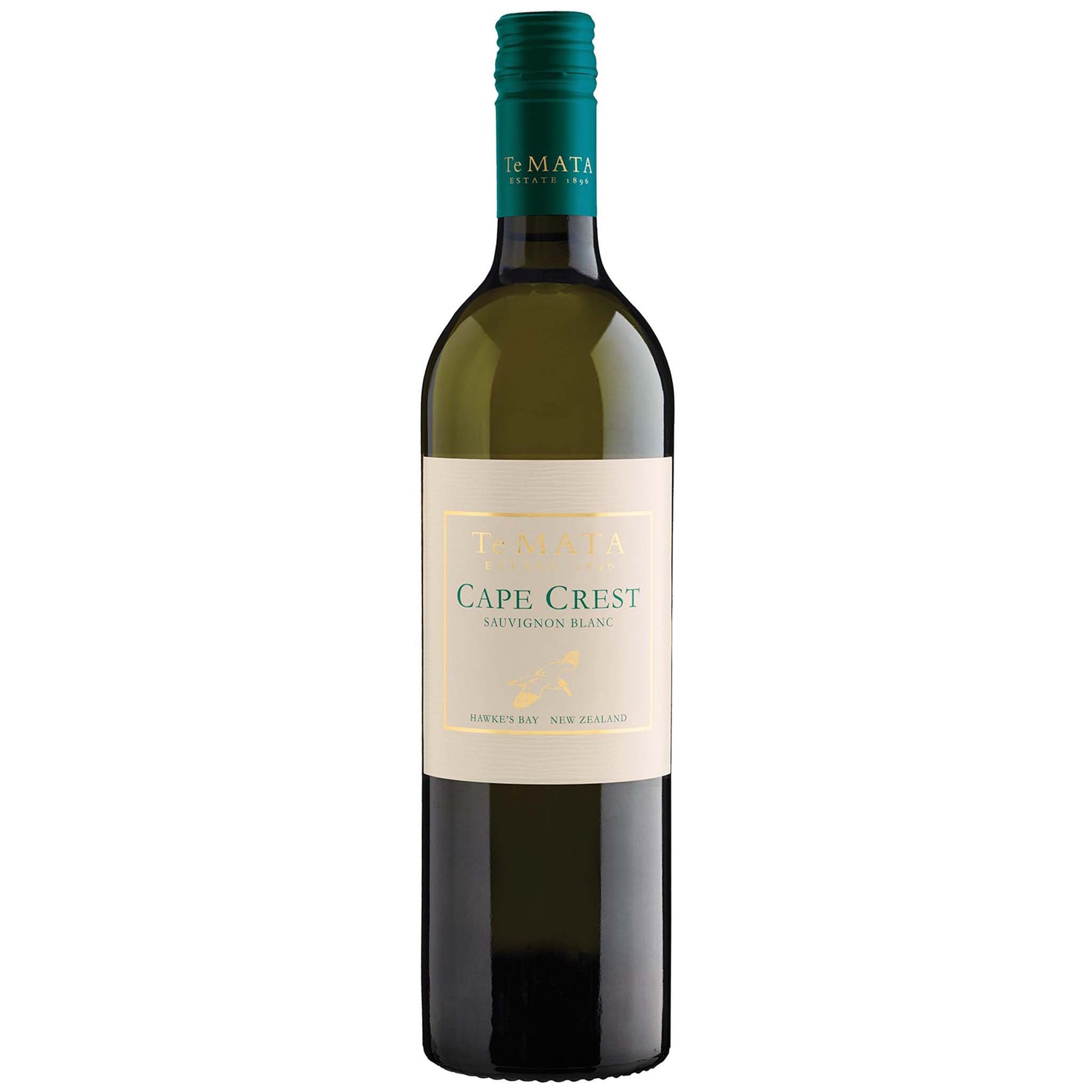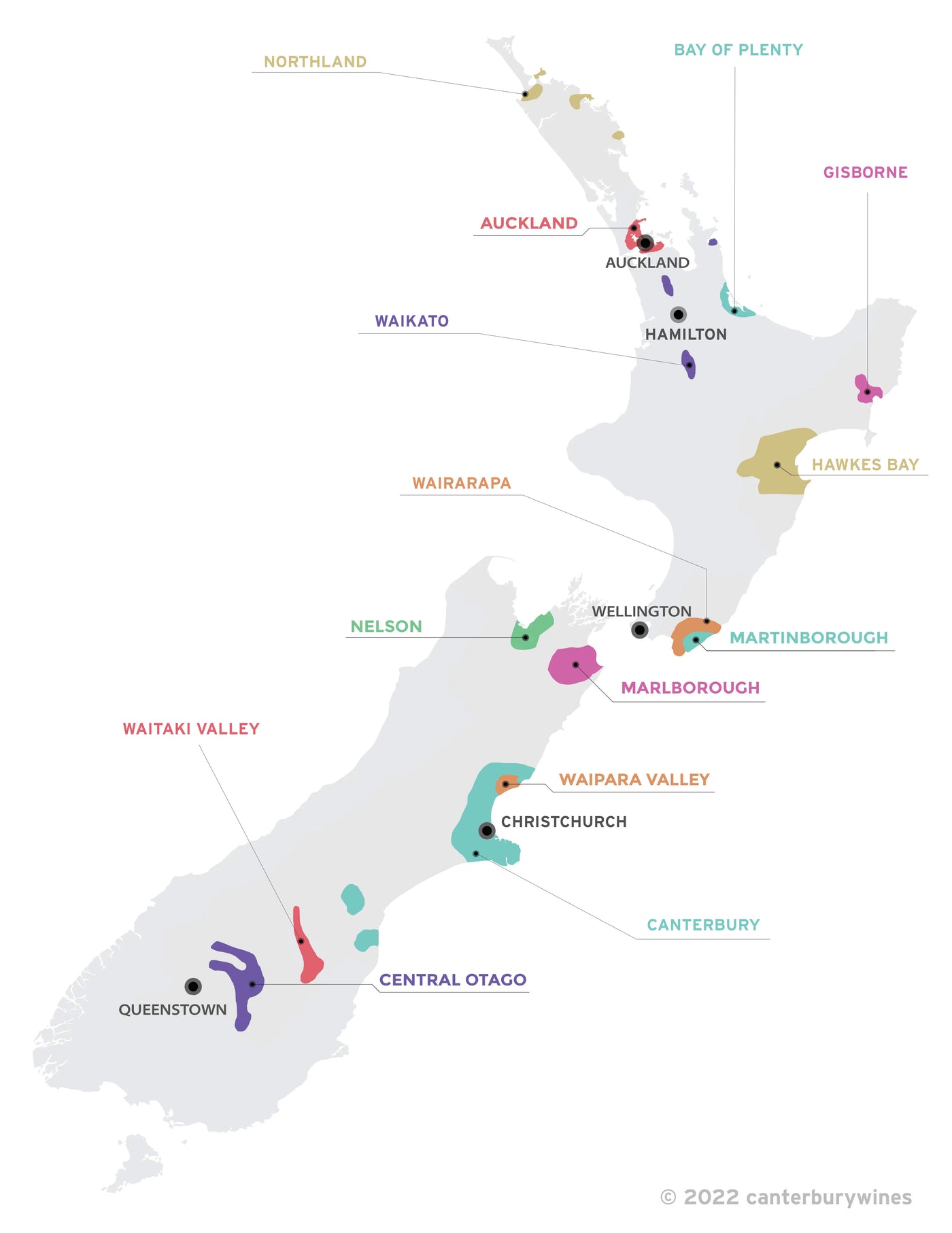

Te Mata Estate Cape Crest Sauvignon Blanc 2021
Style: White Wine
Closure: Screwcap
Te Mata Estate Cape Crest Sauvignon Blanc 2021
Warehouse
34 Redland Drive
Vermont VIC 3133
Australia
Critic Score: 96 and ★★★★★
Alcohol: 13.0%
Size: 750 ml
Drink by: 2036
"Te Mata's Cape Crest aligns with the Bordeaux model of dry, oak-influenced, ageworthy Sauvignon Blanc – and absolutely bears comparison with the great whites of Pessac-Léognan and Graves." Richard Hemming MW
The 2021 Cape Crest is a blend of predominantly Sauvignon Blanc (87%) with small quantities of Sauvignon Gris and Semillon that was fermented and matured in French oak barriques for 11 months. The fruit comes from the Isosceles vineyard in the Bridge Pa subregion which was planted in 1990 and 2000. To quote Richard Hemming MW, "The result is a lip-smacking combo of butter, cream and spice that comes from from the oak and malolactic conversion, alongside box-fresh citric fruit and leafy notes that are the hallmarks of the variety."
"Pineapple, fresh strawberry with green bits, guava, cinnamon oak, a touch of match stick. Saline, crunchy, fresh pineapple, creamy, some vanilla and spiced oak, clean and fleshy, nashi pear, pink grapefruit, oregano and thyme (quite a few things, really), fine chalk dust texture, a gentle grassiness and youthful oak bobs up on a long finish. These wines age very well, so while good now, no hurry if you like them with some extra complexity." Gary Walsh
"A bright and pale straw colour, Cape Crest Sauvignon Blanc '21 immediately offers up notes of guava, lime juice, white nectarine and white peach, that all lead into a palate exploding with tropical fruit, salinity, and a fine, crystalline acidity. The complexing notes of woodsmoke, grapefruit and juniper in Cape Crest Sauvignon Blanc '21 make it satisfying now yet more than capable of ageing. Moreish and complex, this a wine of immense reward. Cape Crest '21 will continue to evolve in the bottle for 10 years from harvest.
The separate parcels were each destemmed and lightly crushed, then cooled before a brief period of skin contact. Following pressing and cold-settling, they were run to a mixture of new and seasoned French oak barrels for fermentation. The resulting wines were aged on lees, with regular stirring, for a further 11 months before bottling in February 2022. Cape Crest '21 is a blend of 87% sauvignon blanc, 9% sauvignon gris and 4% semillon." Te Mata Estate
Te Mata Estate Winery
Expert reviews
"For the second vintage in a row this Bordeaux-styled Sauvignon Blanc, barrel fermented in new and seasoned French oak, stood out for me in a lineup of Te Mata's flagship wines. It was very similar to my memory of the 2020 vintage that preceded it; the palate incredibly intense, fresh and juicy with a backbone of vibrant acididity, but complexed by the barrel maturation which adds wonderful creaminess, spices and oak nuances to the flavours." Nick Munday, Canterbury Wines - 96+ points and Special Value Wine ★
"Light yellow hue leads into a powerful bouquet of nutty, spicy barrel-fermented aromas well meshed with ripe sauvignon fruit aromas, the palate likewise intense and long, with great volume and concentration as well as wonderful focus. A top barrel fermented style of savvy. Drink 2023-2032." Huon Hooke, The Real Review - 96 points
"Combining stunning fruit purity with elegant complexity, the wine shows crunchy apple, fig, kaffir lime and white floral aromas with a hint of savoury pastry. The palate displays excellent focus and drive, wonderfully complemented by fine texture and perfectly pitched acidity, finishing superbly long and vibrant. At its best: now to 2035." Sam Kim, Wine Orbit – 96 points
"This oak-aged Hawke's Bay label is impressive for its ripely herbal, complex, sustained flavours. Most of the grapes are handpicked in the company's relatively warm Bullnose Vineyard, inland from Hastings (the rest is grown at Woodthorpe, in the Dartmoor Valley), and the blend includes small proportions of Sémillon (to add longevity) and Sauvignon Gris (which contributes weight and mouthfeel). The wine is fully fermented and lees-aged for eight to eleven months in French oak barriques (partly new). Bright, light lemon/green, the 2021 vintage (5*) is a richly fragrant, mouthfilling wine, with concentrated, ripe, tropical fruit flavours, finely integrated oak adding complexity, and a very harmonious, long finish. A distinctive, delicious wine, drinking well now, it should be at its best 2024+." Michael Cooper Buyer’s Guide to New Zealand Wines ★★★★★
"It's 87% Sauvignon Blanc, 9% Sauvignon Gris, 4% Semillon. 30% new oak. Pineapple, fresh strawberry with green bits, guava, cinnamon oak, a touch of match stick. Saline, crunchy, fresh pineapple, creamy, some vanilla and spiced oak, clean and fleshy, nashi pear, pink grapefruit, oregano and thyme (quite a few things, really), fine chalk dust texture, a gentle grassiness and youthful oak bobs up on a long finish. These wines age very well, so while good now, no hurry if you like them with some extra complexity. Drink: 2022 - 2030+." Gary Walsh, The Wine Front - 94 points
"The 2021 Cape Crest Sauvignon Blanc is a mélange of hand-picked estate fruit: Sauvignon Blanc, Semillon and Sauvignon Gris. The wine has aromas of French pear, spring flowers and green apple skins, chalky, talc-y and floral, and there's freshness and texture. The oak is essentially invisible but lends a texturing hand to the phenolics. Low pH here gives the tension and energy. Sauvignon Gris is a seasoning, offering a strawberry/ tropical note, bison grass, straw and smoked cassis. The clay gives a punchy nettle-y, gooseberry, lantana note. The Semillon is restrained. Malolactic fermentation is blocked, and the wine sees 11 months élevage sur lie in French oak (30% new). Drink: 2023 - 2031." Erin Larkin, Wine Advocate - 94 points
Awards
Special Value Wine – Canterbury Wines ★
About Cape Crest
 Nick Buck discusses Te Mata Estate Cape Crest (click on image to play video)
Nick Buck discusses Te Mata Estate Cape Crest (click on image to play video)
The following article by Richard Hemming MW appeared in jancisrobinson.com
Most Sauvignon Blanc from New Zealand follows a tried-and-tested formula, and while its global popularity seems undimmed there are few that appeal to the highly engaged wine drinker. But not all Sauvignon Blancs are made equal; you say tomato, I say Te Mata.
Rather than the Marlborough model of gooseberries and grassiness, Te Mata's Cape Crest aligns with the Bordeaux model of dry, oak-influenced, ageworthy Sauvignon Blanc – and absolutely bears comparison with the great whites of Pessac-Léognan and Graves.
The 2020 vintage is a blend of 85% Sauvignon Blanc, 9% Sémillon and 6% Sauvignon Gris, fermented and matured in French oak barriques (of which 30% were new) for 11 months, which is very much the traditional recipe for the style. The result is a lip-smacking combo of butter, cream and spice that comes from from the oak and malolactic conversion, alongside box-fresh citric fruit and leafy notes that are the hallmarks of the variety.
Te Mata are best known for their reds, especially the much-admired Coleraine Bordeaux blend, but when tasting their range recently it was Cape Crest that stood out for me. Not only are the flavours both utterly delicious and wholly representative of an underrated style, but it also has a beguiling waxiness that would make it an ideal partner for many types of dish. I can imagine it holding up equally well to seafood salads, creamy sauces, or even local lamb cooked with Moroccan spices.

The fruit comes from their vineyards in the Bridge Pa subregion, pictured above, which were planted in 1990 and 2000 – relatively recent considering Te Mata's first vines were planted in 1892. The name Cape Crest, incidentally, is a reference to the most southerly point of Hawke's Bay, home to a colony of gannets, one of which adorns the label. The first vintage was 1984 and this wine was, most unusually for a New Zealand white, bottled exclusively under cork until the 2020 vintage – very bordelais!
I asked the team at Te Mata about this and senior winemaker Phil Brodie responded: 'We have gone to screwcap with Cape Crest from the 2020 vintage. The winemaking finishes the day the customer opens the bottle. We love Cape Crest in its youth, but also with bottle age. We have our own bottling line and started a screwcap closure trial 15 years ago looking at different screwcap brands having different wad compositions with varying oxygen transmission rates (OTRs). We then analysed and tasted the wines over the years to see how they evolved aromatically and texturally before committing to a particular brand and wad.'
Commercial sales manager Vince Labat adds, 'We went with a 50/50 screwcap/cork mix for vintage 2020 and 2021. We are transitioning some markets across to the screwcap who have long had the cork. Hence taking this approach. It has been well accepted so as of the 2022 vintage it will be 100% screwcap.'
Te Mata's own cellaring guide suggests the wine can last for 20 years – and I wouldn't disagree. Great oaked Sauvignon Blanc is certainly one of the few great white wines that can benefit from maturity, so don't let age dissuade you.
About the winery

Te Mata Estate was established in 1896, specialising in high-quality wines of classical style. The winery remains family owned, producing internationally recognized wines exclusively from its Hawke's Bay vineyards.
"New Zealand's first growth" - Andy Howard MW, Decanter Magazine
"A national treasure" - Jancis Robinson MW
"New Zealand's greatest winery" - Robert Parker's Wine Advocate
Te Mata Estate was originally part of Te Mata Station, a large pastoral land-holding established by English immigrant, John Chambers, in 1854. After returning from France, John Chamber's third son, Bernard, had the idea to plant vineyards on the north-facing hills around Havelock North. In 1892 he planted vines on three parcels of hillside land above the homestead and began converting the original stables to ferment and mature the wines. The first vintage wines were released in 1986. Today, Te Mata Estate still uses those same three vineyards.
The Chambers family sold the property in 1919. The property had two other owners until John and Wendy Buck acquired Te Mata Estate in 1978 and instigated a twenty-year development program, which commenced with the restoration of the original winery building and the replanting of all of the original vineyards. In addition, new vineyard sites were acquired in the Bridge Pa, Gimblett Gravels and Dartmoor Valley sub-regions of Hawke's Bay (refer map below). The Buck family have been producing Te Mata wines ever since. The success of Te Mata's wines in the '80s is credited with sparking the revival of Hawke's Bay as a top wine region.

Te Mata Estate Winery and Hawke's Bay sub-regions

New Zealand
New Zealand is home to more than 700 wineries across 14 wine regions. The regions are Auckland, Bay of Plenty, Canterbury, Central Otago, Gisborne, Hawkes Bay, Marlborough, Martinborough*, Nelson, Northland, Waikato, Waipara Valley, Wairarapa and Waitaki Valley. * Martinborough is a sub-region of Wairarapa, however, as it is world renowned it is considered here to be a region to avoid confusion.
The wine regions in New Zealand stretch from latitudes 36°S (Northland) in the north (comparable in latitude to Jerez, Spain), to 45°S (Central Otago) in the south (comparable in latitude to Bordeaux, France). New Zealand's climate is maritime, producing cooler summers and milder winters than would be expected at similar latitudes in Europe.
Viticulture in New Zealand dates back to 1836 when British resident James Busby produced wine in the far north, but it wasn't until 1985 that the wine industry came of age when Cloudy Bay Sauvignon Blanc garnered international attention and critical acclaim.
New Zealand is internationally renowned for Sauvignon Blanc (particularly from Marlborough), Pinot Noir (Central Otago, Martinborough and Waipara Valley), Chardonnay, Bordeaux-style blends of mainly Merlot and Cabernet Sauvignon (Hawkes Bay) and Syrah (Hawkes Bay). Sauvignon Blanc accounts for 63% of the area of the national vineyard, followed by Pinot Noir (14%), Chardonnay (8%), Pinot Gris (7%) and Merlot (3%).

